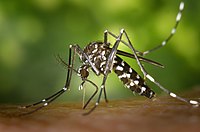
Photo from wikipedia
Newly emerging or re-emerging infections are posing continuous threat to both public health system and clinical care globally. The emergence of infections especially caused by arboviruses can be linked to… Click to show full abstract
Newly emerging or re-emerging infections are posing continuous threat to both public health system and clinical care globally. The emergence of infections especially caused by arboviruses can be linked to several mechanisms which include geographical expansion linked to human development and transportation, global warming, enhanced transmission in peridomestic area and close proximity of human habitations to domestic as well as wild animals. The co-circulation of Dengue, Chikungunya and Zika is a matter of public health priority due to the fact that they are transmitted by the same vector as well as increase in the number of reported cases of severe dengue, post-chikungunya chronic joint disease and microcephaly related to Zika virus disease. The study was designed to estimate the prevalence of these arboviral infections in Odisha. About 5198 cases presenting with common clinical symptoms of fever, arthralgia, headache, myalgia and malaise were screened during 2016–2019. A total of 42.2% patients tested positive for dengue NS1 antigen (n = 4154), 30.2% for dengue IgM (n = 2161) and 14.3% for chikungunya IgM (n = 1816). A total of 1684 samples were subjected to Zika RT-PCR and none was tested positive. Peak in the numbers of dengue/ chikungunya cases was evident in the post-monsoon months of July – October. Circulation of all four serotypes of dengue i.e. DEN 1, 2, 3, and 4 was noticed in the state. Molecular investigation of suspected Chik cases in early phases showed circulation of Eastern Central Southern African genotype (E1:226A). There is dearth of knowledge about disease severity during arbovirus co-infections and importance of adequate management of patients at an early stage residing in risk areas. It is the first study in Odisha to study the pattern and status of these three arboviral diseases Dengue, Chikungunya and Zika. The outcome of this study will help in focusing and improvement of existing surveillance systems and vector control tools, as well as on the development of suitable antiviral agents and formulating candidate vaccine.
Journal Title: VirusDisease
Year Published: 2021
Link to full text (if available)
Share on Social Media: Sign Up to like & get
recommendations!